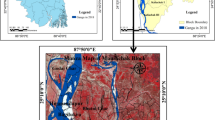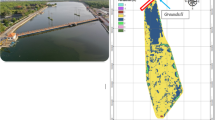Abstract
The dynamics associated with the morphological changes of the Ganga River being the largest river in India is yet to be understood. Population living near the floodplain gets crucially affected by migrating channels. Spatiotemporal relocation of Ganga River from Buxar to Azamabad over a period of 45 years (1975–2020) was measured using Landsat images. Study area was divided into 7 reaches (A, B, C, D, E, F and G) based on availability of field data. Temporal changes (at 5-year interval) of river centerline, bank line positions, area within banks, channel migration rates and sinuosity ratios have been computed and analyzed. Analysis suggests that river has experienced considerable course change and readjustment in configuration over the last 45 years with centerline and bank lines shifting of about 11.5 km during this period in leftward direction and about 8.6 km in rightward direction. With an average sinuosity ratio of about 1.32 in the study region, Ganga River can be classified as sinuous river except for Reach F in which the river is meandering. The channel's fluctuating lateral movement appears to be affected by strong fluvial hydraulics and the reactivation of cross-bar channels inside river valleys.











Similar content being viewed by others
Availability of Data and Material
Authors are thankful to Central Water Commission Patna, providing the field surveyed datasets of Ganga River.
References
Ashmore, P. E. (1982). Laboratory modelling of gravel braided stream morphology. Earth Surface Processes and Landforms, 7(3), 201–225.
Chakraborty, S., & Mukhopadhyay, S. (2015). An assessment on the nature of channel migration of River Diana of the sub-Himalayan West Bengal using field and GIS techniques. Arabian Journal of Geosciences, 8(8), 5649–5661.
Chitale, S. V. (1970). River channel patterns. Journal of the Hydraulics Division, 96(1), 201–221.
Debnath, J., Pan, N. D., Ahmed, I., & Bhowmik, M. (2017). Channel migration and its impact on land use/land cover using RS and GIS: A study on Khowai River of Tripura, North-East India. The Egyptian Journal of Remote Sensing and Space Science, 20(2), 197–210.
Friend, P. F., & Sinha, R. (1993). Braiding and meandering parameters. Geological Society, 75(1), 105–111.
Garde, R.J. (2006). Fluvial Morphology. In: R.J. Garde, ed. River Morphology. New Age International (P) Limited, Publishers, pp 71–109.
Giardino, J. R., & Lee, A. A. (2011). Rates of channel migration on the Brazos River. Department of Geology & Geophysics, Texas A & M University.
Goswami, U., Patgiri, A. D., & Sarma, J. N. (1999). Hydrological properties of soil from textural analysis: A case study of lower Subansiri basin, Assam. Journal of Indian Association of Sedimentologists, 18(2), 261–269.
Gupta, N., Atkinson, P. M., & Carling, P. A. (2013). Decadal length changes in the fluvial planform of the River Ganga: Bringing a mega-river to life with Landsat archives. Remote Sensing Letters, 4(1), 1–9.
Gurnell, A. M., Downward, S. R., & Jones, R. (1994). Channel planform change on the River Dee meanders, 1876–1992. Regulated Rivers: Research & Management, 9(4), 187–204.
Leopold, L. B., & Wolman, M. G. (1957). River channel patterns: braided, meandering, and straight. US Government Printing Office.
Osterkamp, W. R. (1998). Processes of fluvial island formation, with examples from Plum Creek, Colorado and Snake River, Idaho. Wetlands, 18(4), 530–545.
Pati, J. K., Lal, J., Prakash, K., & Bhusan, R. (2008). Spatio-temporal shift of western bank of the Ganga River, Allahabad city and its implications. Journal of the Indian Society of Remote Sensing, 36(3), 289–297.
Raj, C., & Singh, V. (2020). Assessment of planform changes of the Ganga River from Bhagalpur to Farakka during 1973–2019 using satellite imagery. ISH Journal of Hydraulic Engineering, pp 1–11.
Rudra, K. (2010). Dynamics of the Ganga in West Bengal, India (1764–2007): Implications for science–policy interaction. Quaternary International, 227(2), 161–169.
Schumm, S. A. (1963). Sinuosity of alluvial rivers on the Great Plains. Geological Society of America Bulletin, 74(9), 1089–1100.
Shukla, U. K., Srivastava, P., & Singh, I. B. (2012). Migration of the Ganga River and development of cliffs in the Varanasi region, India during the late Quaternary: Role of active tectonics. Geomorphology, 171, 101–113.
Singh, I. B., & Singh, M. (1992). The Ganga River valley: Alluvial valley in active foreland basin (abstract): 29th International Geological Congress, Kyoto, Japan, Abstracts. II-, 5–6, 406.
Singh, S., Prakash, K., & Shukla, U. K. (2020). Spatiotemporal Migration of the River Ganga in Middle Ganga Plane: Application of Remote Sensing and GIS Technique. Journal of the Indian Society of Remote Sensing, 48(11), 1495–1507.
Singh, I. B., Ansari, A. A., Chandel, R. S., & Misra, A. (1996). Neotectonic control on drainage system in Gangetic Plain, Uttar Pradesh. Journal of Geological Society of India (Online archive from Vol 1 to Vol 78), 47(5), 599–609.
Sinha, R., & Ghosh, S. (2012). Understanding dynamics of large rivers aided by satellite remote sensing: A case study from Lower Ganga plains, India. Geocarto International, 27(3), 207–219.
Srivastava, A., & Singh, R. P. (1999). Surface manifestation over a subsurface ridge. International Journal of Remote Sensing, 20(18), 3461–3466.
Swamee, P. K., Parkash, B., Thomas, J. V., & Singh, S. (2003). Changes in channel pattern of river ganga between mustafabad and rajmahal, gangetic plains since 18th century. International Journal of Sediment Research, 18(3), 219–231.
Thakur, P. K., Laha, C., & Aggarwal, S. P. (2012). River bank erosion hazard study of river Ganga, upstream of Farakka barrage using remote sensing and GIS. Natural Hazards, 61(3), 967–987.
Wallick, J. R., Grant, G. E., Lancaster, S. T., Bolte, J. P., & Denlinger, R. P. (2007). Patterns and controls on historical channel change in the Willamette River, Oregon, USA. In Gupta, A. (editor) Large Rivers: Geomorphology and Management. , Wiley, pp 491–516.
Winterbottom, S. J. (2000). Medium and short-term channel planform changes on the Rivers Tay and Tummel, Scotland. Geomorphology, 34(3–4), 195–208.
Acknowledgements
Authors are thankful to Central Water Commission Patna, providing the field surveyed datasets of Ganga River.
Funding
The authors did not receive support from any organization for the submitted work.
Author information
Authors and Affiliations
Corresponding author
Ethics declarations
Conflict of interest
All authors certify that they have no affiliations with or involvement in any organization or entity with any financial interest or non-financial interest in the subject matter or materials discussed in this manuscript.
Additional information
Publisher's Note
Springer Nature remains neutral with regard to jurisdictional claims in published maps and institutional affiliations.
About this article
Cite this article
Kumar, R., Jha, R. Assessment of Spatiotemporal Migration of River Ganga from Buxar to Azamabad Using Remote Sensing and GIS Technique. J Indian Soc Remote Sens 50, 1945–1958 (2022). https://doi.org/10.1007/s12524-022-01583-y
Received:
Accepted:
Published:
Issue Date:
DOI: https://doi.org/10.1007/s12524-022-01583-y




